|
|
|
Sort Order |
|
|
|
Items / Page
|
|
|
|
|
|
|
| Srl | Item |
| 1 |
ID:
124221
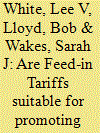

|
|
|
|
|
| Publication |
2013.
|
| Summary/Abstract |
Feed-in Tariffs (FITs) implemented by city councils in the USA have proven an effective means of stimulating installation of renewable-electricity generation capacity at a local level, and may also be effective for New Zealand cities. Though New Zealand has a high proportion of electricity generated renewably, this is mostly from centralized hydroelectricity plants. The suitability of city-level FITs for promoting solar photovoltaic panels in New Zealand is examined. Findings suggest that FITs, with rates obtained using the cost-of-generation method, could be implemented in New Zealand cities at rates comparable to those in successful FIT schemes internationally. The unique structure of New Zealand's liberalized electricity market, however, is likely to make financing FIT schemes at city-level more complex than the equivalent situation in the USA. Benefits of introducing such schemes will include the possibility for purchasers of solar PV systems to calculate returns on investment over the long term, and the streamlining of the grid connection process by reducing the number of authorities involved.
|
|
|
|
|
|
|
|
|
|
|
|
|
|
|
|
| 2 |
ID:
103458
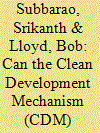

|
|
|
|
|
| Publication |
2011.
|
| Summary/Abstract |
The paper investigates whether the Clean Development Mechanism (CDM) under the Kyoto Protocol has played a significant role in the development of rural communities, specifically investigating uptake of small-scale renewable energy projects. The investigation involved an assessment of 500 registered small-scale CDM projects under the Kyoto Protocol in terms of their potential impact on the envisaged sustainable development goals for rural communities. Five case studies from the Indian subcontinent were also examined.
The paper concludes that the CDM in its current state and design has typically failed to deliver the promised benefits with regard to development objectives in rural areas. Successful projects were found to have had good community involvement and such projects were typically managed by cooperative ventures rather than money making corporations. The paper puts forward a new framework for the assessment of such benefits in the hope that future projects can be better assessed in this regard. The key problem, however, remains on how to deal with the inherent contradiction between development and sustainability.
|
|
|
|
|
|
|
|
|
|
|
|
|
|
|
|
| 3 |
ID:
088048
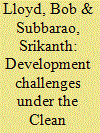

|
|
|
|
|
| Publication |
2009.
|
| Summary/Abstract |
The "Sustainable Development" aspect of the Clean Development Mechanism (CDM) under the Kyoto Protocol is examined, with regard to its current impact on crucial developmental issues.
The paper discusses the immediate and urgent global concerns of developmental needs, energy and climate change, whilst highlighting their influence on the poor in the developing world. The global responses to address the above concerns in terms of renewable energy technologies, policies and strategies that can be instrumental in addressing the issues are discussed, with main emphasis on the CDM under the Kyoto Protocol. The critical issue of whether the CDM can address poverty alleviation and sustainable development in developing countries is discussed in the context of existing market principles, transparency of the mechanism, economics and the daunting bureaucratic procedures involved.
The paper concludes that the CDM, if suitably modified, can go some way to address sustainable development and alleviate poverty for poor rural areas and not increase emissions by a focus on renewable energy technologies. This result can be achieved as the energy consumption of rural sectors is currently so small relative to developed economies that only small additional renewable energy generation capacities are needed to make a measurable difference.
|
|
|
|
|
|
|
|
|
|
|
|
|
|
|
|
| 4 |
ID:
133228
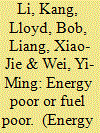

|
|
|
|
|
| Publication |
2014.
|
| Summary/Abstract |
Energy poverty and fuel poverty are descriptors of problems of households' energy consumption, they are both distinct problems and have been addressed by many researchers, organizations and governments. Cross use of the terms of energy poverty and fuel poverty in published papers is common. As an accurate descriptor is the presupposition of research and policy development, especially for those who just started to pay attention to this issue, this paper compares the definitions, research priorities, status quo, and problems of these two concepts, and summarizes the relationship between them. The paper suggests that only when the research targets are households who are living in a cold climate and have difficulty in getting access to electricity or modern cooking facilities, and in supplying indoor heating with appropriate cost, the concepts of energy poverty and fuel poverty have the chance to be broadened and mutually integrated.
|
|
|
|
|
|
|
|
|
|
|
|
|
|
|
|
| 5 |
ID:
112237
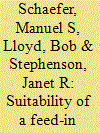

|
|
|
|
|
| Publication |
2012.
|
| Summary/Abstract |
New Zealand (NZ) aims to expand the deployment of wind energy as one means to achieve 90% of electricity generation from renewables by 2025 and in addition to reduce green house gas (GHG) emissions. Due to electricity market regulations that inhibit market entry for independent developers, New Zealand's wind energy development has been limited to primarily large wind farms developed by a handful of electricity utilities. In contrast to many other countries, NZ lacks policy support for entry of smaller investors into the wind generation sector.
In order to gage the acceptability of a feed in tariff (FIT) for wind energy in New Zealand, a survey questionnaire (366 respondents) with land owning farmers and semi structured interviews with wind energy stakeholders was conducted. Although international literature suggests that a FIT would be the most suitable policy support scheme to accelerate wind energy deployment, this conclusion was not reached by many influential stakeholders in NZ. However, a majority of the surveyed farmers supported the introduction of a FIT for wind energy. The study also revealed that farmers' acceptance of wind energy in their local area increases with their awareness about climate change issues.
|
|
|
|
|
|
|
|
|
|
|
|
|
|
|
|
| 6 |
ID:
099364
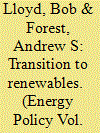

|
|
|
|
|
| Publication |
2010.
|
| Summary/Abstract |
This paper explores energy and physical resource limitations to transitioning from fossil fuels to the large-scale generation of electricity with photovoltaic arrays. The model finds that business as usual models, which involve growth rates in world electricity demand of between 2% and 3.2% p.a., exhibit severe material difficulties before the end of this century. If the growth rate is lowered to 1% p.a., then it may be possible to reach the year 2100 before such difficulties, but it is likely that material constraints will occur early the next century. Steady state scenarios show that silicon based photovoltaic panels could, however, displace fossil fuels before the middle of the century, providing around the same order of magnitude as present (2010) world electricity demand. Scenarios also show that outcomes will be highly dependent upon the rate of improvement of photovoltaic technologies. The analysis does not contend that silicon PV technology is the only technology that will or can be adopted, but as the embodied energy content per kWh generated of this technology is similar to other renewable technologies, such as other solar technologies and wind, it can provide a baseline for examining a transition to a mixture of renewable energy sources.
|
|
|
|
|
|
|
|
|
|
|
|
|
|
|
|
|
|
|
|
|